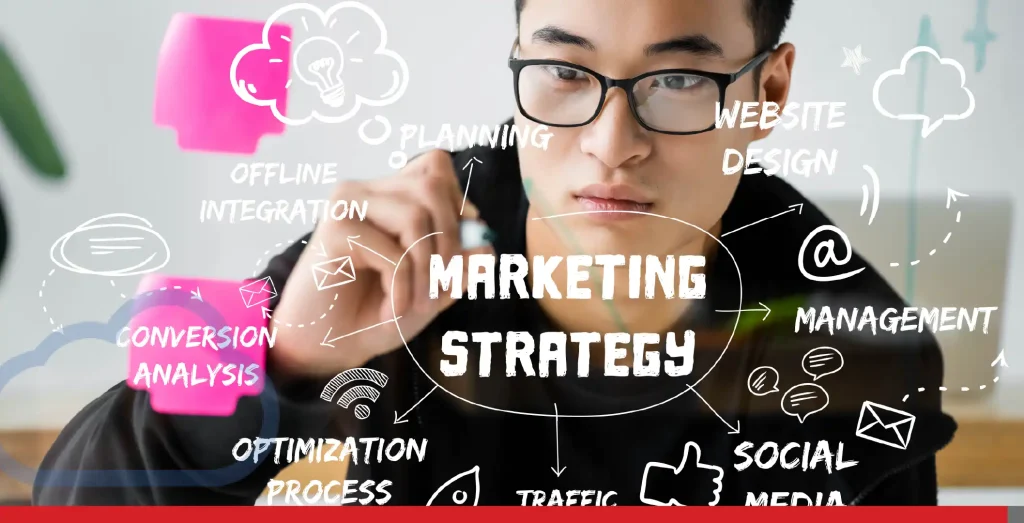Have you ever clicked on a product advertisement only to find the same product pop up when you browse social media, read an email, or visit a brick-and-mortar store? This isn’t just clever marketing—it’s omnichannel marketing in action.
In a world where 73% of consumers use multiple channels during their shopping journey, businesses that fail to deliver consistent experiences risk losing customer loyalty, sales, and revenue.
But how do you create an omnichannel strategy that works?
Let’s explore everything you need to know about omnichannel marketing, its benefits, and how EasyHosting’s tools—such as web hosting, email, and digital marketing services—can help you implement this game-changing approach.
- What Is Omnichannel Marketing?
- Omnichannel & Multichannel Marketing: What Are the Main Differences?
- Who Can Benefit from Omnichannel Marketing?
- What Do I Need to Do to Get Started with Omnichannel Marketing?
- Are Paid Ads Necessary for Omnichannel Marketing?
- Mapping the Entire Customer Journey
- Developing Your Omnichannel Marketing Strategy
- Examples of Omnichannel Marketing

What Is Omnichannel Marketing?
Imagine this: A customer gets an email about a promotion for a new electric bike. They click through to your website to learn more about it. Later, they scroll through social media, and see an ad for the same product and buy it through your app.
This is omnichannel marketing. And you’ve successfully completed a sale that could have otherwise been lost to a competitor or neglected altogether.
Why Does It Matter?
- 87% of retailers say omnichannel is a prime factor for their business.
- Businesses with strong omnichannel engagement and helpful customer interaction retain 89% of customers vs 33% of businesses with weak omnichannel.
Omnichannel & Multichannel Marketing: What Are the Main Differences?
At this stage, we need to understand the difference between multichannel and omnichannel marketing to get customer engagement right.
Multichannel Marketing is engaging customers across multiple channels, like websites, social media and physical stores. Each channel is standalone with its own strategy and goals to maximize reach and engagement on that specific platform.
Omnichannel Marketing is where all channels, including digital channels, are connected to give a seamless and consistent customer experience. This means interactions across all platforms are linked so that customers can move between channels without interruption.
Main differences:
- Integration and consistency: Omnichannel marketing is about a unified customer experience across all channels, including digital channels. Multichannel marketing may not have this integration, and customers get disjointed experiences.
- Customer-centric: Omnichannel strategies put the customer at the centre, and experiences are tailored to their behaviour and preferences. Multichannel strategies focus on individual channel performance, not the overall customer journey.
- Personalization: Omnichannel marketing uses data to personalize across all touchpoints while increasing customer satisfaction and loyalty. Multichannel marketing may not use data integration to the same extent and may send generic messages.

Who Can Benefit from Omnichannel Marketing?
Omnichannel marketing is not just for large corporations. It’s a strategy that can be adjusted and tried on businesses of all sizes. Whether you’re a small business looking to expand or a large enterprise aiming to revise customer engagement, omnichannel marketing has something to offer.
- Small businesses: If you’re just starting, omnichannel marketing allows you to create a seamless experience across your website, email, social media, and other channels without the need for complex infrastructure. EasyHosting’s affordable web hosting and email marketing tools can help you engage your audience across these touchpoints, ensuring you don’t miss out on potential customers.
- Medium-sized businesses: As your business develops, maintaining a unified customer experience across channels becomes more stringent. EasyHosting’s digital marketing services, along with its reliable web hosting and email marketing tools, help you scale up your omnichannel efforts while keeping customer interactions consistent, personalized, and insightful.
- Large enterprises: For large enterprises, omnichannel marketing enables deeper customer insights and greater customer retention. By integrating data from multiple sources (for example, CRM, social media, and email), you can deliver a truly personalized experience. EasyHosting’s robust digital marketing solutions and web hosting infrastructure can help large businesses manage their vast data needs and execute advanced marketing strategies across multiple channels.
Transform your business; join EasyHosting with a brand new website, email, and domain.
What Do I Need to Do to Get Started with Omnichannel Marketing?
So, what do you need to do to get started with omnichannel marketing? Here’s how you can set the foundation for our strategy in 5 easy steps:
1. List Your Current Channels
Start by listing all the platforms and channels your business uses, including websites, social media profiles, email marketing campaigns, and physical stores. What’s their purpose, and how are they currently engaging with customers?
- Check for integration: Do your channels talk to each other? For example, is social media driving traffic to your website and is your website driving email sign-ups or in-store visits?
- Review branding: Make sure your logo, tone, visuals, and messaging are consistent across all platforms.
2. Know Your Customer
Knowing your customer is the foundation of an omnichannel strategy.
- Analyze customer data: Use analytics tools to gather data on preferences, purchase behaviour, and most used channels.
- Create personas: Build profiles of your ideal customer, detailing their pain points, preferences, and the platforms they use. This way, you can tailor content and strategy to their needs at every touchpoint.
3. Make It Easy to Work With
Your customers should feel like they’re interacting with 1 brand, no matter where or how they interact.
- Bridge digital and physical channels: For example, allow customers to redeem online offers in-store or see in-store inventory on your website.
- Simplify messaging: Keep tone and style consistent across all interactions, whether social media, email, or in-store conversations.
4. Invest in Technology
- Use integration friendly solutions: Use CRMs and automation platforms that allow data to flow between channels.
- Optimize your website: Make sure it’s fast, mobile-friendly, and easy to use, as it’s often the central hub of your strategy. The website should work flawlessly regardless of whether it’s browsed from a desktop or mobile device.

5. Test & Measure Everything
Continuous testing is the dominant factor in discovering what’s working and what’s not.
- Measure across channels: Use KPIs such as website traffic, conversion rates, email open rates, and social media engagement to measure performance.
- Fix weak spots: Where are customers dropping off or disengaging and making changes, such as simplifying forms or improving checkout?
- Iterate based on data: Regularly test new approaches and adjust your strategy based on performance insights to ensure long-term success.
Are Paid Ads Necessary for Omnichannel Marketing?
Paid ads aren’t mandatory for an omnichannel strategy, but they can greatly amplify your efforts by:
- Accelerating reach: Especially useful for new businesses or when launching new products. Marketing them in multiple ways and via multiple channels can greatly revamp their effectiveness and boost sales.
- Targeting specific audiences: Platforms like Google and social media offer audience segmentation.
- Boosting engagement across channels: Paid ads can drive traffic to your website, social media profiles, and email lists, strengthening your overall strategy.
Pro Tip: Start small with paid ads, analyze their impact, and enlarge your budget as you see results. Balancing paid efforts with organic strategies ensures sustainable growth.
Mapping the Entire Customer Journey
Customer Touchpoints & Interactions
Mapping the customer journey starts with every interaction a customer has with your brand—across online and offline channels. From discovering your product on social media to visiting your website or opening an email, every touchpoint contributes to personalized customer journeys.
- Find your key touchpoints: Where do customers engage with your brand most? Email campaigns, social media ads, or checkout pages?
- Map the journey: Understand the customer’s perspective, goals, and pain points at each stage.
- Leverage data: Use customer data to enhance these interactions, creating tailored experiences that address their needs.
Create a 360-Degree View of the Customer
A comprehensive customer view integrates data from all channels to deliver personalized experiences.
- Unify data across channels: Centralize insights from websites, emails, social media, and in-store activity.
- Create customer segments: Group customers based on behaviour, preferences, and purchase history for targeted engagement.
- Personalize every interaction: Use these insights to create relevant, tailored experiences at every stage of the journey.
Using Customer Data to Refine the Journey
Customer data is the foundation of a seamless journey.
- Analyze trends: Identify patterns in behaviour and interactions to perfect touchpoints.
- Improve continuously: Refine weak areas, such as high drop-off points or low-performing channels.
- Track satisfaction (e.g. the success metrics): Use feedback and retention metrics to measure success and adjust strategies accordingly, ensuring personalized and relevant content is delivered at each stage of the customer journey.

Developing Your Omnichannel Marketing Strategy
Wondering where to start? Follow these 5 steps to build a winning strategy:
1. Set Clear Goals
What do you hope to achieve? Is it more sales, higher retention, or better brand awareness? Define your objectives and the KPIs that will track your progress.
2. Understand Your Audience
Do you know your customers’ preferences? Use data to segment your audience based on behaviour, demographics, and buying habits. EasyHosting’s digital marketing services can help you organize and analyze this data productively.
3. Build a Cohesive Content Strategy
What do your customers want to see? Personalize your messaging to each audience segment and deliver it consistently across channels.
4. Streamline the Customer Journey
Where do your customers interact with you the most? Map their journey to identify critical touchpoints, from social media ads to email campaigns. Integrate EasyHosting’s professional email and web hosting tools to create a seamless experience.
5. Use the Right Tools
Technology is the backbone of your omnichannel approach. Ensure your platforms work together. For example:
- Use EasyHosting’s dependable web hosting to manage your website.
- Leverage email marketing tools to send personalized offers.
- Run targeted digital ad campaigns across channels.
Examples of Omnichannel Marketing
To get a sense of omnichannel marketing, let’s look at 2 scenarios that show how a connected strategy, including brick-and-mortar stores, drives results:
1. Retail: Turning Browsers into Buyers
Imagine a customer visiting an online retailer’s website and adding a product to their cart but leaving without completing the purchase. What happens next?
- Step 1: Email reminder: The customer receives a personalized email reminding them of the item left in their cart.
- Step 2: Social media follow-up: The next day, they see a targeted ad on their social media feeds offering a 10% discount on the item. This can happen even if the user didn’t have an account at the retailer’s website but enabled personalization cookies, for example.
- The result: The customer returns to the website and completes the purchase. This cycle helps the overall customer journey and customer experience.
2. eCommerce: Post-purchase Loyalty
Consider an online store using tools like EasyHosting’s email marketing to create a comprehensive post-purchase strategy.
- Step 1: Personalised thank you email: After purchase, they get a customized email thanking them and recommending related products.
- Step 2: Upsell with social media ads: A week later, they see ads on Instagram for related products and a limited-time offer.
- Step 3: Retention: A month later, they get an email with a loyalty discount to buy again.
Why It Works
- Consistency across channels: The same message resonates whether it’s delivered via email, social media, or the website.
- Data-driven personalization: Leveraging customer data ensures every interaction feels relevant and timely.
- Customer-centric approach: Customers appreciate the convenience of interconnected touchpoints that meet their needs seamlessly.

Summing It Up
Omnichannel marketing is no longer optional—it’s a necessity in today’s interconnected world. By unifying your channels and focusing on customer-centric strategies, you can build trust, loyalty, and revenue.
Ready to take the first step? With EasyHosting’s web hosting, domains, email, and digital marketing services, you have everything you need to create a seamless omnichannel experience.
Start your journey today and turn every touchpoint into a winning connection with EasyHosting.
FREQUENTLY ASKED QUESTIONS
What are the 3 aspects of omnichannel marketing?
The 3 main aspects of omnichannel marketing are:
- Integration: All channels and touchpoints are interconnected to provide a seamless experience. This integration allows customers to move fluidly between platforms.
- Personalization: Data is used to personalize the customer experience across all touchpoints, ensuring relevant and timely interactions.
- Consistency: A consistent message and experience are delivered across all channels, whether it’s through email, social media, or in-store interactions.
What tools are essential for businesses implementing omnichannel marketing?
- Web hosting platforms: A fast, consistent web hosting plan for a business website is the backbone of your online presence.
- Email marketing software: For sending personalized, automated communications.
- CRM systems: To unify customer data across touchpoints.
- Analytics tools: To track engagement and sharpen performance.
How do I measure the success of my omnichannel marketing efforts?
Key Performance Indicators (KPIs) to monitor include:
- Customer Lifetime Value (CLV): The total revenue a customer generates over their relationship with your brand.
- Conversion rates: The percentage of interactions that lead to desired actions, such as purchases.
- Customer retention rates: The ability to keep customers engaged and returning.
What are the best components of a successful omnichannel marketing strategy?
A successful strategy includes:
- Customer journey mapping: Identifying and understanding all customer touchpoints.
- Data Integration: Unifying customer data across channels to create a 360-degree view.
- Personalization: Tailoring content and offers based on customer behaviour and preferences.
How do I integrate omnichannel marketing into my business model effectively?
Integration begins with aligning your tools and channels:
- Evaluate your current customer touchpoints (for example, website, social media, and email).
- Centralize your data using a CRM or unified dashboard.
- Ensure consistent and personalized messaging and branding across all platforms.
What are the common pitfalls to avoid when adding omnichannel marketing?
Some to avoid:
- No integration: Not connecting your channels means fragmented customer experiences.
- Ignoring data: Not using data to personalize customer interactions makes everything feel generic and disconnected.
- Mixed messaging: Make sure your messaging and tone are the same across all platforms; mixed signals confuse customers.
- Overcomplicating the customer journey: A seamless experience is key—don’t add extra steps that will frustrate customers or break the flow across touchpoints.



